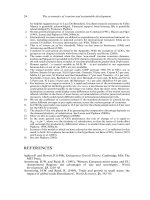THE ECONOMICS OF MONEY,BANKING, AND FINANCIAL MARKETS 591
Bạn đang xem bản rút gọn của tài liệu. Xem và tải ngay bản đầy đủ của tài liệu tại đây (44.32 KB, 1 trang )
CHAPTER 21
The Demand for Money
559
ulative motive. Although Keynes took the transactions and precautionary components of the demand for money to be proportional to income, he reasoned that
the speculative motive would be negatively related to the level of interest rates.
Keynes s model of the demand for money has the important implication that
velocity is not constant but instead is positively related to interest rates, which
fluctuate substantially. His theory also rejected the constancy of velocity because
changes in people s expectations about the normal level of interest rates would
cause shifts in the demand for money that would cause velocity to shift as well.
Thus Keynes s liquidity preference theory casts doubt on the classical quantity
theory that nominal income is determined primarily by movements in the quantity of money.
FU RTH ER DE VE LO PM EN T S I N T HE
KEYN E SIA N AP PROACH
After World War II, economists began to take the Keynesian approach to the
demand for money even further by developing more precise theories to explain
the three Keynesian motives for holding money. Because interest rates were
viewed as a crucial element in monetary theory, a key focus of this research was
to understand better the role of interest rates in the demand for money.
Transactions
Demand
William Baumol and James Tobin independently developed similar demand for
money models, which demonstrated that even money balances held for transactions purposes are sensitive to the level of interest rates.6 In developing their
models, they considered a hypothetical individual who receives a payment
once a period and spends it over the course of this period. In their model,
money, which earns zero interest, is held only because it can be used to carry
out transactions.
To refine this analysis, let s say that Grant Smith receives $1000 at the beginning of the month and spends it on transactions that occur at a constant rate during the course of the month. If Grant keeps the $1000 in cash in order to carry
out his transactions his money balances follow the sawtooth pattern displayed in
panel (a) of Figure 21-2. At the beginning of the month he has $1000, and by the
end of month he has no cash left because he has spent it all. Over the course of
the month, his holdings of money will on average be $500 (his holdings at the
beginning of the month, $1000, plus his holdings at the end of the month,
$0, divided by 2).
At the beginning of the next month, Grant receives another $1000 payment,
which he holds as cash, and the same decline in money balances begins again. This
process repeats monthly, and his average money balance during the course of the
year is $500. Since his yearly nominal income is $12 000 and his holdings of money
average $500, the velocity of money (V * PY/M) is $12 000/$500 * 24.
Suppose that as a result of taking a money and banking course, Grant realizes
that he can improve his situation by not always holding cash. In January, then,
he decides to hold part of his $1000 in cash and puts part of it into an incomeearning security such as bonds. At the beginning of each month, Grant keeps
6
William J. Baumol, The Transactions Demand for Cash: An Inventory Theoretic Approach, Quarterly
Journal of Economics 66 (1952): 545 556; James Tobin, The Interest Elasticity of the Transactions
Demand for Cash, Review of Economics and Statistics 38 (1956): 241 247.









